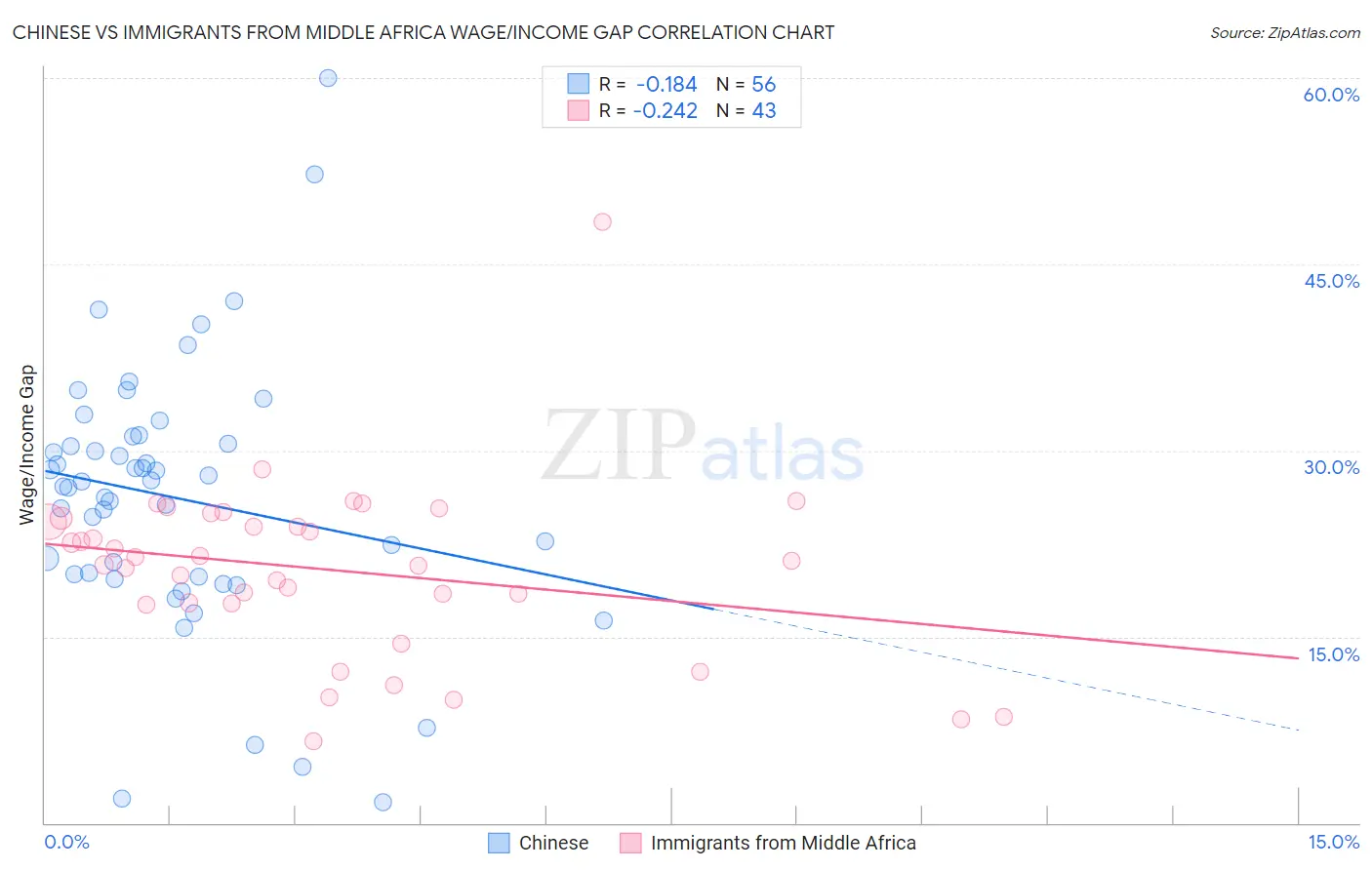Chinese vs Immigrants from Middle Africa Wage/Income Gap
COMPARE
Chinese
Immigrants from Middle Africa
Wage/Income Gap
Wage/Income Gap Comparison
Chinese
Immigrants from Middle Africa
25.9%
WAGE/INCOME GAP
42.0/ 100
METRIC RATING
178th/ 347
METRIC RANK
22.4%
WAGE/INCOME GAP
100.0/ 100
METRIC RATING
60th/ 347
METRIC RANK
Chinese vs Immigrants from Middle Africa Wage/Income Gap Correlation Chart
The statistical analysis conducted on geographies consisting of 64,807,074 people shows a poor negative correlation between the proportion of Chinese and wage/income gap percentage in the United States with a correlation coefficient (R) of -0.184 and weighted average of 25.9%. Similarly, the statistical analysis conducted on geographies consisting of 202,693,436 people shows a weak negative correlation between the proportion of Immigrants from Middle Africa and wage/income gap percentage in the United States with a correlation coefficient (R) of -0.242 and weighted average of 22.4%, a difference of 15.8%.

Wage/Income Gap Correlation Summary
| Measurement | Chinese | Immigrants from Middle Africa |
| Minimum | 1.7% | 6.5% |
| Maximum | 60.0% | 48.4% |
| Range | 58.3% | 41.9% |
| Mean | 26.2% | 20.4% |
| Median | 27.3% | 21.1% |
| Interquartile 25% (IQ1) | 19.9% | 17.7% |
| Interquartile 75% (IQ3) | 30.9% | 24.5% |
| Interquartile Range (IQR) | 10.9% | 6.9% |
| Standard Deviation (Sample) | 10.8% | 7.1% |
| Standard Deviation (Population) | 10.7% | 7.1% |
Similar Demographics by Wage/Income Gap
Demographics Similar to Chinese by Wage/Income Gap
In terms of wage/income gap, the demographic groups most similar to Chinese are Cambodian (25.8%, a difference of 0.21%), Samoan (26.0%, a difference of 0.23%), Guamanian/Chamorro (26.0%, a difference of 0.27%), Paraguayan (25.8%, a difference of 0.32%), and Sri Lankan (25.8%, a difference of 0.33%).
| Demographics | Rating | Rank | Wage/Income Gap |
| Immigrants | Greece | 56.6 /100 | #171 | Average 25.7% |
| Immigrants | Chile | 53.2 /100 | #172 | Average 25.7% |
| Immigrants | Belarus | 52.9 /100 | #173 | Average 25.7% |
| Alaskan Athabascans | 50.0 /100 | #174 | Average 25.8% |
| Sri Lankans | 47.0 /100 | #175 | Average 25.8% |
| Paraguayans | 46.7 /100 | #176 | Average 25.8% |
| Cambodians | 45.1 /100 | #177 | Average 25.8% |
| Chinese | 42.0 /100 | #178 | Average 25.9% |
| Samoans | 38.6 /100 | #179 | Fair 26.0% |
| Guamanians/Chamorros | 38.0 /100 | #180 | Fair 26.0% |
| Immigrants | Bolivia | 36.4 /100 | #181 | Fair 26.0% |
| Immigrants | Serbia | 35.4 /100 | #182 | Fair 26.0% |
| Immigrants | Kazakhstan | 35.2 /100 | #183 | Fair 26.0% |
| Mexicans | 34.4 /100 | #184 | Fair 26.0% |
| Pakistanis | 33.7 /100 | #185 | Fair 26.1% |
Demographics Similar to Immigrants from Middle Africa by Wage/Income Gap
In terms of wage/income gap, the demographic groups most similar to Immigrants from Middle Africa are Navajo (22.4%, a difference of 0.020%), Immigrants from Cuba (22.4%, a difference of 0.060%), Ghanaian (22.3%, a difference of 0.14%), Immigrants from Fiji (22.4%, a difference of 0.17%), and Immigrants from Ghana (22.3%, a difference of 0.24%).
| Demographics | Rating | Rank | Wage/Income Gap |
| Bangladeshis | 100.0 /100 | #53 | Exceptional 22.2% |
| Nepalese | 100.0 /100 | #54 | Exceptional 22.2% |
| Immigrants | Zaire | 100.0 /100 | #55 | Exceptional 22.3% |
| Immigrants | Ghana | 100.0 /100 | #56 | Exceptional 22.3% |
| Ghanaians | 100.0 /100 | #57 | Exceptional 22.3% |
| Immigrants | Cuba | 100.0 /100 | #58 | Exceptional 22.4% |
| Navajo | 100.0 /100 | #59 | Exceptional 22.4% |
| Immigrants | Middle Africa | 100.0 /100 | #60 | Exceptional 22.4% |
| Immigrants | Fiji | 100.0 /100 | #61 | Exceptional 22.4% |
| Immigrants | Guatemala | 100.0 /100 | #62 | Exceptional 22.5% |
| Immigrants | Ecuador | 100.0 /100 | #63 | Exceptional 22.5% |
| Spanish American Indians | 100.0 /100 | #64 | Exceptional 22.5% |
| Guatemalans | 99.9 /100 | #65 | Exceptional 22.6% |
| Central American Indians | 99.9 /100 | #66 | Exceptional 22.7% |
| Menominee | 99.9 /100 | #67 | Exceptional 22.7% |